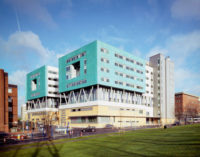The Modern Wing: Where a Familiar Type Soars
Renzo Piano’s Modern Wing at the Art Institute of Chicago isn’t simply the best new building to hit Chicago in years. It represents the triumph of a type — the art museum with parallel masonry walls, generous expanses of glass, and an oversailing roof that serves as a louvered sunshade for galleries below. When Piano introduced this type at his Beyeler Foundation Museum near Basel, Switzerland, in 1997, it was overshadowed by the hoopla surrounding Frank Gehry’s eruption of titanium in Bilbao. Yet time has revealed the Beyeler model to be both durable and flexible. It has now winningly reappeared in his diminutive Nasher Sculpture Center in Dallas as well as the large-scale Modern Wing, which, at an imposing 264,000 square feet, makes the Art Institute the nation’s second-largest art museum.
These similar but distinct iterations, which effortlessly synthesize Classical repose and Modern translucency, naturally offend critics for whom architecture is a never-ending quest for novel shapes. But Piano is unafraid to reuse and reimagine his type. His genius is to adapt it to distinct conditions of function, scale, and site, which in Chicago includes a choice spot across from Millennium Park, the city’s new town square. Millennium Park is packed with attention-getting architecture and public sculpture, including Frank Gehry’s exuberant Pritzker Pavilion and its headdress of stainless steel. The last thing the park needed was another self-aggrandizing “wow” building on its borders. Instead, Piano wisely endeavored to produce an accumulation of ever-shifting, sensory delights — a journey that would ward off museum fatigue by entrancing the viewer at every step.
That journey begins with the Modern Wing’s handsome proportions and exquisite details, from its “flying carpet” of light-filtering, aluminum blades to the pencil-shaped steel columns that support the roof. Like other Piano buildings of this type, the Modern Wing reads as an X-ray that reveals its structure and its contents. Here, Piano simultaneously channels — and writes a new chapter in — the interrelated Chicago traditions of structural expressionism and curtain-wall transparency. And he proves equally adept at negotiating and knitting together the disparate architectural statements around him.
The Modern Wing uses the same Indiana limestone that faces all of the Art Institute’s earlier structures, including its 1893 Beaux-Arts building, yet it is clearly in tension with them — a temple, yes, but a Modern temple of steel, aluminum, and glass. Piano demonstrates equal skill in addressing the Pritzker Pavilion and its domelike trellis, equipped with suspended speakers, that sails over a great lawn. Against Gehry’s “umbrella for sound,” he juxtaposes his own “umbrella for sight.” The result is not a starchitect smackdown, as some commentators have characterized it, but a genuine dialogue between 21st-century masters. It makes a vibrant civic place where just five years ago there was nothing but commuter railroad tracks, a surface parking lot, and an undistinguished rear entrance to the museum. Piano seals the connection with a gently sloping, 620-foot-long pedestrian bridge that leads visitors directly from Millennium Park to the wing’s popular rooftop restaurant.
Many critics have rightly noted a similarity between Piano’s Classicizing Modernism and that of Mies van der Rohe, but the comparison breaks down inside the Modern Wing. Piano doesn’t do Miesian universal space. He particularizes his interior, whether it be the Modern Wing’s skylit, streetlike atrium, the main galleries devoted to European Modern and contemporary art, or the architecture and design galleries, which boast more square footage than their counterparts at New York’s Museum of Modern Art. The result is a splendid showcase, in which architecture’s presence is always felt, but never dominates. The natural light, ever changing due to shifting weather conditions, is the Modern Wing’s glory, continuing the Art Institute’s century-old tradition of exhibiting works of art in diffuse natural light. True, as Piano and his clients have acknowledged, the light and other aspects of the wing need “tuning.” But the Modern Wing’s exemplary adaptation of an existing type evokes Herman Melville’s poem Greek Architecture: “Not magnitude, not lavishness/But Form — the Site;/Not innovating willfulness/But reverence for the Archetype.”




Post a comment to this article
Report Abusive Comment